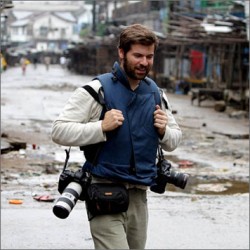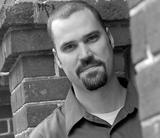
Chris Hondros Severely Wounded in Libya

Earlier today, there were reports out of Libya that regular VQR contributor Chris Hondros has been killed in a mortar attack in Misrata, where he has recently been working for Getty Images covering house-to-house fighting between pro-Gaddafi forces and rebel militants. Hondros’s representative at Getty told me by phone that they did not have any direct information. But Andre Liohn, a French photographer, wrote on his Facebook page that he had been at the hospital with Hondros and Academy Award-nominated documentary filmmaker Tim Hetherington when both were declared dead. However, the New York Times is reporting that Hondros appears to be alive, but with a severe brain injury. (Photographs now surfacing online appear to confirm this.)
As our dedicated readers will know, Chris has been a staple in the pages of VQR in recent years. His first piece—a short essay about crawling into Saddam’s spider hole, shortly after Hussein’s capture—appeared in my second issue as editor. Chris was a recent nominee for a Pulitzer Prize, and I was honored to have the piece for VQR, but he was modest and ebullient. “I’ve been going around in a bit of a daze lately,” he wrote me, “considering that my amateur-hack writer self has actually contributed to such an august publication… at cocktail parties I’ve been dying for the conversation to come around to Saddam’s capture and spider-hole, so that I could seize the moment and intone with a grave ‘as I mentioned in my essay on the matter in the Virginia Quarterly Review…’”
After that, we met up occasionally when I was in New York. Chris took me to a favorite noodle place near Union Square. We went to an awful party together in lower Manhattan that he wisely bailed on as soon as it became clear that neither of us was hip enough by half. And he contributed photos to the Winter 2007 issue (including the cover) and the Summer 2007 issue. The latter story, an essay and collection of his photos shot from inside American Humvees called “A Window on Baghdad,” was a finalist for the National Magazine Award for Photojournalism.
We hung out before the ceremony at his Brooklyn apartment, with its commanding view of the East River. Chris has been to enough award shows to be nonchalant. He had his own rumpled tux and puttered around his place until it was practically time for the ceremony to begin. What I didn’t know—as I poked through his sixties-era stacks of Esquire and Rolling Stone and eyed the clock—was that Chris had a press license plate, which allowed him to park anywhere. He sauntered out to his car, which was double-parked and cock-eyed on Tillary, and drove us right to the edge of Columbus Circle, where he threw on the parking brake and hopped out like he was abandoning the vehicle for good. He has that kind of confidence and swagger.
But I hope no one will mistake that self-assurance for recklessness or a death-defier bravado. There is none of that with Chris. A couple of years ago when I wrote to say that I would be in New York, he responded that he was back in Baghdad. “I go to Iraq every six months for about three to five weeks, and have ever since this boondoggle began,” he wrote me, “and will continue to as long as the bulk of the US military is here and as long as billions of dollars of our money are poured onto these burning sands. I’m an American overseas journalist; there’s really no getting around doing periodic time in Iraq. I see it as a civic responsibility as much as anything else.”
He regarded his work in Haiti last year and his work in Cairo in February the same way—not as an adrenaline-driven ego trip but as a job and a duty. I’m sure he felt the same way about his reporting efforts in Misrata—and I pray that they will not be his last. Without Chris in the field reporting, our grasp of the unfolding story in Libya will be diminished. But to confront the day’s news without his clear-eyed and sensitive perspective altogether seems unthinkable. The world would just be too hard to understand.
UPDATE (April 21): The New York Times reports that Chris Hondros died yesterday about 10 PM after several hours in a coma. The story also identifies Michael Christopher Brown, who was one of the photographers featured in the Winter issue of VQR, as another of the wounded photographers. Brown, according to the story, “suffered shrapnel wounds to his left shoulder, but his life was not in danger.” We hope for a swift recovery for Michael and will always be grateful to have known and worked with Chris.

